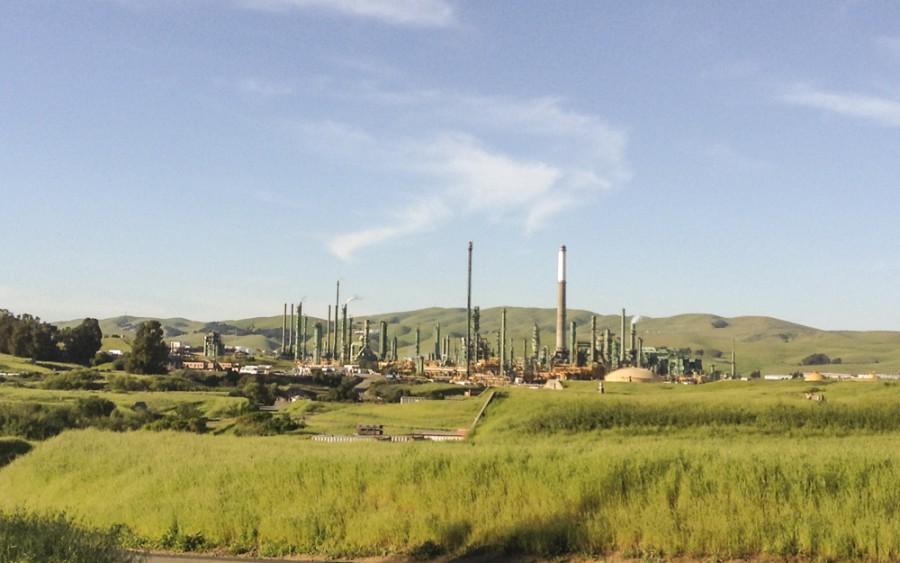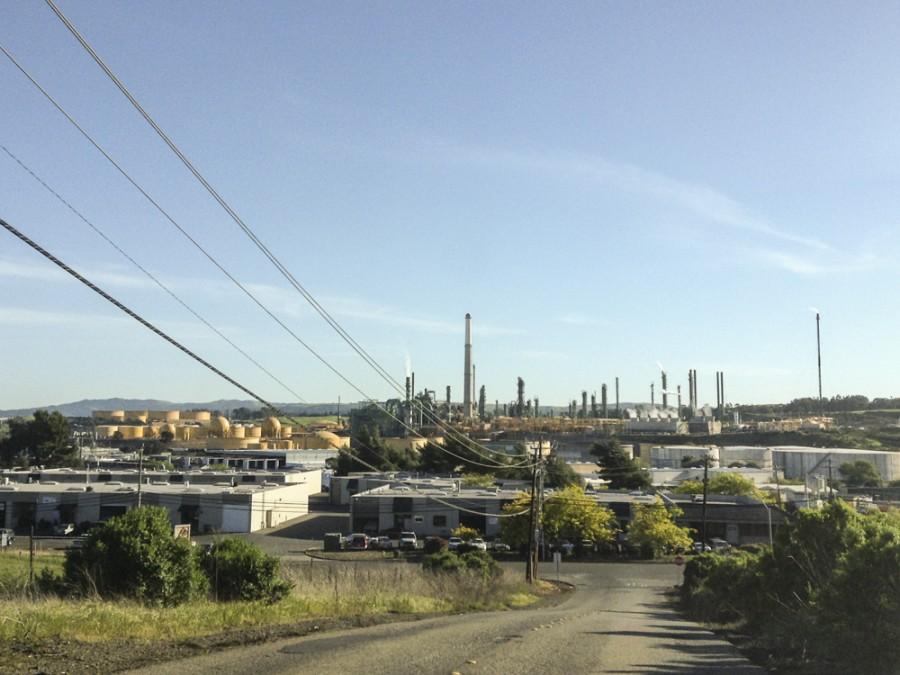Crude oil by rail a possibility in Benicia
April 6, 2016
A controversial proposal by the Valero oil refinery that would bring in thousands of tons of crude oil a day has some Benicia residents seriously questioning whether it’s time to peel the “It’s Better in Benicia” bumper stickers from the backs of their cars and relocate.
Originally proposed in 2013, the project would bring 70,000 barrels of crude oil into the Benicia oil refinery facility by roughly 100 railroad tank cars daily. It would not increase the amount of crude currently brought to the refinery through pipeline and marine vessels, but instead would replace 81 percent of the oil imported by ship. According to Valero, the refinery can process up to 170,000 barrels of oil per day.
Trains have been known to derail, and in cases where crude oil was on board, have killed people, ruined the environment and destroyed the value of entire towns. Benicia residents are divided on whether the transportation developments are necessary and worth the risk to the environment.
The Benicia City Council heard Valero’s appeal for the project on March 15, which was initially rejected the city planning commission, after four nights of hearings and public comment, on Feb. 11 where over 145 people signed up to speak, according to Amy Million, principal planner of the city. The planning commission reviewed the final Environmental Impact Report (EIR) before unanimously concluding that the potential risks to the environment in the event of a derailment or unloading accident were too significant to justify approval.
After hearing Valero’s appeal a month later, the city council is currently deliberating whether or not to approve the crude by rail project.
Three proposed possible train routes between the Southern California border, Roseville and Benicia would follow the Union Pacific railroad and pass through various cities throughout the state before arriving in Benicia. According to the Revised Draft EIR, project-related train traffic on the train routes would generate nitrogen oxide emissions that could turn into ozone, which could exceed air quality standards in air districts along the routes. This is considered one of the 11 significant unmitigatable impacts on which the planning commission based its decision to deny the proposal.
Nitrogen Oxide (NOx) is a poisonous gas and air pollutant that is emitted by automobiles, industrial sources and fuels that contain nitrogen, such as oil, according to the United States Environmental Protection Agency. When mixed with volatile chemicals in the presence of sunlight, it can form ozone, also known as smog; a gas that can cause serious respiratory damages when inhaled. According to the EPA, ozone can cause coughing, throat irritation and even reduce lung function, and is one of two pollutants that pose the greatest threat to human health in this country.
Fifty nine letters opposing the project were published in the final EIR, many containing concerns about the harmful effects that rail transportation could have on the environment. Valero’s crude by rail project was proposed shortly after a 74-car freight train carrying crude oil derailed in Lac-Megantic, Quebec, a town of roughly 6,000. Forty-seven people were killed and nearly 6 million liters of oil seeped into the land, water and atmosphere during the fire that ensued, according to the Montreal Gazette. Many residents are worried that a similar disaster could occur in Benicia, a city of roughly 28,000.
“I have a two-year-old grandchild and I worry how this will affect him,” said 16-year Benicia resident Beverly Edmonds, 67. “Will he be living in this lovely place or a toxic, decimated shell of a town or will his health be affected by toxic fumes or the effects of a rail disaster?”
According to Mario Giuliani, the city’s economic development manager, oil refineries were the city’s saving grace when the Benicia Arsenal, a military reservation next to the Suisun Bay, closed down due to lack of funding and employment opportunities in the early 1960’s. According to the city of Benicia, the arsenal was a staging area for several wars and employed thousands of people before its closure in 1964. With the displacement of so many people, the town suffered a major economic downturn according to Giuliani.
According to The Benicia Herald, Humble Oil bought some of the vacant former arsenal land in 1967. Not long after, it changed hands again when it sold to the Exxon Oil Company. The refinery’s presence brought in the oil industry and anchored the economy in Benicia, replacing many, if not all or more, of the jobs that were lost after the arsenal closure, according to Benicia city officials. Valero bought the refinery from Exxon in 2000 and currently provides over 400 jobs. According to the EIR, the project would create 20 permanent full-time jobs and 120 temporary jobs.
From the $3 million in property taxes that the refinery pays the city annually, the city only keeps 24 cents on the dollar and the rest goes to the county, schools and other programs in the area, explained Guiliani.
According to Sue Fisher Jones, public affairs manager of Valero, the Benicia refinery is one of only two in California to earn the Voluntary Protection Program “Star Site” designation, which recognizes organizations that have implemented health and safety programs that successfully control occupational hazards. The refinery earned its title in 2006 and has since passed two recertification audits. The other refinery with this designation is the Valero located in South Los Angeles.
“I have lived in Benicia since 2003 (worked at Valero since 2005) and have never experienced a community Shelter-in-Place,” Jones told The Pioneer. Shelter-in-place is an emergency response plan in which people hunker indoors to avoid hazardous air pollution.
A Facility Profile Report by the EPA revealed that Valero released 1,068,877 pounds of chemicals into the environment in 2014. The total amount released in the United States for that year was 3.4 billion pounds.
Andres de Soto, spokesperson and steering committee member for Benicians for a Safe and Healthy Community (BSHC) helped form the organization around the time of Valero’s proposal in 2013. BSHC opposed the project from the beginning and recommended that it be reviewed under the California Environmental Quality Act (CEQA) which requires agencies to identify the potential significant environmental impacts of their projects in an EIR.
The EIR looks at all the potential scenarios and issues of a project and evaluates whether the applicants are equipped to handle them. For example, in the case of a derailment, emergency response teams benefit by knowing what specific type of crude oil is being transported in order to better tackle the specific situation. “The dirtier, the heavier the crude, the more sulfur, creating more noxious emissions,” explained Soto. Valero declined to release the specific type of crude oil to be transported, labeling it a trade secret, according to the EIR.
Giuliani believes that those who don’t support the project don’t necessarily oppose Valero specifically, but oppose the oil refinery process itself. “If they had proposed to bring water in instead, no one would’ve cared,” he said.
Citizens are also concerned about the effect the project will have on the value of property. According to an article in the San Jose Mercury News, a fire at the Richmond Chevron Refinery in August 2012 caused a 14.62 percent drop in property taxes. A 2006 study by Stephen Farber from the University of Pittsburgh confirmed that housing markets are sensitive to real or perceived risks associated with being located close to a site that contains hazardous material, such as a refinery.
“My husband and I probably have another ten good years,” said Edmonds. “At some point we will need to move to something much smaller and easier to care for, or to a retirement home. The money we get from our house will be essential for that.”

















